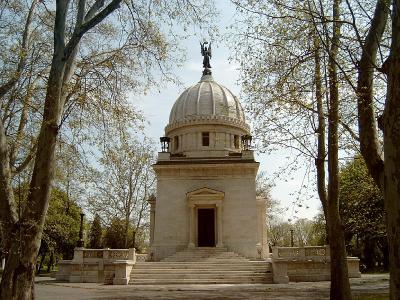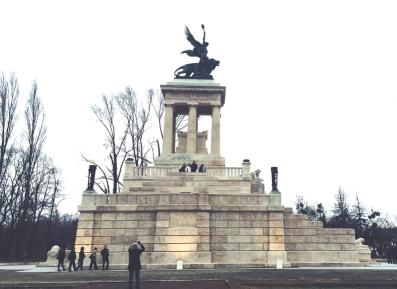|
In partnership with the Hungarian National Heritage Institute, a series of legal tender commemorative coins presenting national memorials began in 2014, with a new coin added every year. (2014: Somogyvár-Kupavár, 2015: Mohács, 2016: New Public Cemetery in Rákoskeresztúr, 2017: Parliament and Kossuth Square.) The 2018 issue is a 2,000 forint, bronze-patinated coin honoring Budapest's Fiumei Road Cemetery.
The coin was designed by the sculptress Márta Csikai. The obverse features a half-view of one of the cemetery’s most well-recognized statues that also is the inspiration for its logo: the statue atop the tomb of the statesman Lajos Kossuth by the sculptor Alajos Stróbl. The winged genius of freedom, strength and enlightenment, holding a torch in one hand is standing behind a lion freed from its chains symbolizing the Hungarian nation. The reverse shows the mausoleum of “The Wise Man of the Nation,” Ferenc Deák, and the walkway leading to it, with gravestones in the background. The 18.4 gram, 37 millimeter coin is limited to an issue of 5,000 pieces. It will be released at the end of June.
 
With a history reaching back almost 170 years, the Fiumei Road Cemetery has become a famous site similar to the Père-Lachaise Cemetery in Paris, but instead of the graves of Molière, Chopin and Jim Morrison one can visit the final resting places of renowned Hungarians such as Ady, Jókai, Arany, Erkel, Faludy, Jancsó and Imre Kertész. There is also a mausoleum for the great national hero Lajos Batthyány in addition to those for Deák and Kossuth. The cemetery was opened in the middle of the 19th century as a public burial ground in Pest, and by the end of that century it was the most important one in Hungary. The cemetery also preserves the memories of the eras since the Revolution of 1848.
More of the great figures from Hungarian history and culture are buried here than anywhere, and many of the monuments designed by famous architects and sculptors are said to have great artistic value. The cemetery has separate sections for artists, Jacobins, and heroes of the 1848 and 1956 revolutions. Almost resembling an arboretum, the huge 138 acre cemetery is also known for its rich flora and fauna. It has been managed by the National Heritage Institute since 2016.
|















